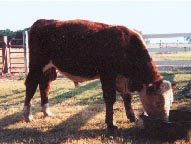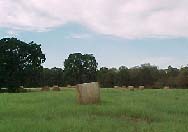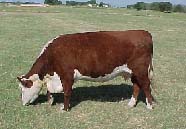In this part of North East Texas, we are blessed with good grass, adequate rains, and a fairly temperate climate. So, our cattle have an opportunity to perform to their best potential without supplemental graining. Our goal here is to utilize the existing forage to it's best potential, and supplement for any deficiencies, or special nutritional requirements. This should provide a balanced protein diet, and keep the cattle performing. Pastures can become overgrazed, mineral deficient, and unproductive over time, so proper management of the natural forage and resources we maintain is very important to our program. It ensures adequate nutritional requirements are met, without the heavy backgrounding you find within other programs.
Supplements: The key to supplementation lies within the quality of the pasture or hay the cattle are feeding on, and the season. When the weather is warm, and we are getting ample rains to keep the grass growing, than the only supplement will normally be a trace mineral block. If cattle are grazing on good protein winter pasture, than they will receive a high magnesium mineral. Breeding and lactating cattle will be given mineral with phosphorus, and a protein supplement. The protein may be in the form of a syrup lick, protein tub or breeder cube. All will be at least 20% protein. Licks and tubs are free choice, the cube is fed. Those cattle "not" on winter grass pasture, or being fed hay only, may also receive a protein supplement depending on the quality of the pasture or Hay. On good quality hay of 14% protein, the cattle may be cubed 1 to 2lbs per head a couple of times a week (this keeps them tame) Our Heifers are treated the same as our cows. Our calves may or may not be introduced to creep feed depending on the type of year, but most calves have been introduced to feed one way or another. We do not maintain feeders that are free choice for our calves. When supplementing calves, they will receive, on an average, 15lbs of feed per 10 head, poured into a trough, 3 to 5 times a week. To see what we feed our show cattle, go to the "Showtime" page. Finally, we have not, we do not, and we will not use growth hormones, or growth stimulants in our cattle We feed our cattle with standard rations, and our show cattle get the same, with an additional fat supplement. We use no suragate or recipient mothers either! All our calves are raised by there own "Hereford" mothers, and have been for over 15 years. We feel this gives an honest evaluation on the animals within or herd program. Recipient cows are however a necessity within our embryo program, and embryo calves will have a recipient mother.
Hay: Some people might classify hay as a supplement, but those people are probably either not limited on land resources, always use winter pastures, or live in southern Florida! I see hay as optimum utilization of existing forage for use when conditions dictate the need for supplemental nutrition! The majority of our hay is coastal bermuda mix or rye grass, and usually baled into round bales. The protein content of our hay will run from 11% to about 14%.  Back
Back
Summer Grazing: Most of our pastures are a mix of coastal, common, and native grasses with an average protein content of about 12% to 14%. The cattle may or may not recieve suplemented protein during the warm season. Supplemental protein will usually only occur during periods of drought or during the early summer breeding season.
Winter /Cool Season Grazing: The summer and warm season grasses will become dormant in the winter and offer virtually no protein. Cattle on these pastures will receive supplemented protein. Some of our pastures will be sewn with annual and perennial winter grasses. We have used Gulf and Tam 90 Ryes, and legumes, such as, Arrowleaf and Red Clover. These are good protein grazing (12% and higher) and are typically reserved for breeding, calving, and lactating cattle. Other pastures will have volunteer growths of rye, vetch, and native cool season grasses. 
 Back
Back
Double
Farms
Double
Farms
We manage our cattles nutrition based on grass, not supplementation! We don't feed our cattle every day, and we don't background our calves with daily creep. We feel that in this way, our cattle will excell in a commercial environment and be economically efficient during their productive life!
You can see what our show cattle are fed by going the the showtime page!
Performance on the Hoof!
Performance on the Hoof!
The Harvey's
Tom and Tina
Cooper, Texas
doublehtx@gmail.com




